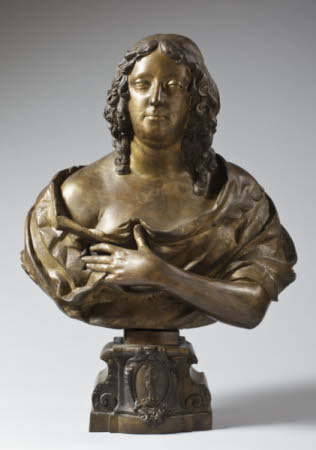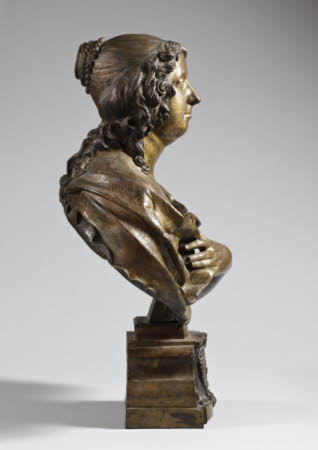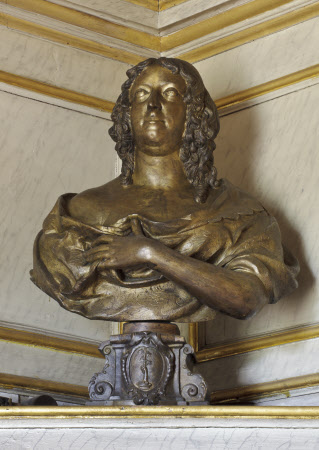Catherine Bruce, Mrs William Murray (d. 1649)
attributed to Peter Besnier (fl.1643, d.1687-93)
Category
Art / Sculpture
Date
circa 1637 - 1639
Materials
Bronze
Measurements
785 x 540 x 340 mm
Place of origin
England
Order this imageCollection
Ham House, Surrey
NT 1139887
Summary
Bronze, Catherine Bruce, Mrs William Murray (died 1649), attributed to Peter Besnier (fl. 1643, died 1687/88), c. 1637-9. A bronze portrait bust of Catherine Bruce, Mrs William Murray, mother of the Countess of Dysart, attributed to the Anglo-French sculptor Peter Besnier (fl. 1643, died 1687/88). The bust depicts the sitter wearing a loose silk robe embellished with floral decoration, that slightly falls from and exposes her right shoulder. Her left arm passes across her front to hold the edge of the robe, to prevent it from falling further. She gazes upwards and slightly to her right. Mrs Murray’s luxuriant hair cascades down each side of her head in loose curls, whilst at the back it is plaited and coiled into a tight bun, held in place by an accessory in the form of a collar of pearls. The bust is fixed by means of three tangs to a separately made socle with scrolled supports, at the centre of which is the Bruce coat-of-arms, a tree issuing from an earl’s coronet.
Full description
The bust is extremely carefully finished, with for example hammering to the sitter’s robe, and the use of a minute punch to stipple the hair and the background of the coat-of-arms. The metal is a brass alloy, with copper (c. 75%) mixed with a high level of zinc (c. 20%) and other smaller quantities of other metals, in particular lead and iron (XRF analysis by Rupert Harris Conservation, April 2011). The bust has in the past often been described as gilded, but in fact this is incorrect. All the brightness is in the metal, the high-zinc brass copper alloy used. The bust formerly had a black lacquer surface, removed by the Victoria & Albert Museum in around 1980. The assumption made at the time of the removal that this was a later covering may not in fact have been correct. The bust is recorded in successive Ham House inventories, in 1677 as above the chimneypiece in the White Closet, its position today. The 1683 inventory identifies it as a portrait of Catherine Bruce, Mrs William Murray, the mother of Elizabeth, later Duchess of Lauderdale. Catherine Bruce was of Scottish birth, daughter of Colonel Norman Bruce and a kinsman of the Earl of Elgin. In around 1626 she married William Murray, a close friend of the future King Charles I since childhood and an ardent royalist supporter, who was heavily engaged both during and after the Civil War in assisting the monarch and his wife and attempting in vain to broker a settlement between Charles and the Scots. Catherine was a lady-in-waiting to Queen Henrietta Maria. During and after the Civil War, she and her four daughters remained mostly in residence at Ham, which was transferred by her husband into her name. She indomitably resisted attempts by the Parliamentary Commissioners to seize the house and suffered numerous fines and other tribulations. William Murray was created Earl of Dysart in 1643, although he did not take up the title until 1751 so that, on her death in 1649, Catherine Murray was recorded without the title on her coffin plate (NT 1139995). The Murrays’ eldest daughter Elizabeth married firstly in 1648 Sir Lionel Tollemache and, subsequently, John Maitland, second Earl of Lauderdale. This exceptional portrait, one of the finest sculptures to survive from the period before the English Civil War, represents the highest level of portraiture in bronze in Britain at this time. It has sometimes been attributed to the French sculptor Hubert Le Sueur (c. 1580-1658), who is first recorded in England in 1626 and worked as sculptor to King Charles I until the Civil War. A competent caster but with little artistic imagination, Le Sueur’s bronze portrait busts, which include images of King Charles I at Stourhead (NT 731855) and Edward Herbert, 1st Baron Herbert of Cherbury at Powis Castle (NT 1181001) appear somewhat flaccid when compared with the vigorous image of Catherine Bruce. It has recently been suggested that it is likely to be the work of another Anglo-French sculptor, Peter Besnier. Peter and his brother Isaac worked for king Charles I before the Civil War and, at the Restoration in 1660, Peter petitioned the new king Charles II for reinstatement to his old position. Confirmation that Peter Besnier did indeed cast in bronze comes from the advertisement he placed in 1663 for sculptures stolen from him, described in the advertisement as ‘one blackmore cast from the life, and three or four other heads’ (Adam White, ‘A Biographical Dictionary of London Tomb Sculptors c, 1560-c. 1660. Addenda and Corrigenda’, The Walpole Society, 71 (2009), pp. 325-355, pp. 329-30). The bust has close stylistic resonances with a pair of plaster busts of Sir William and Lady Fermor, now in Northampton Museums and Art Gallery, which have been attributed to Peter Besnier. The two Fermor busts are placed on bases of similar form, whilst the turn of Mary Fermor’s head, her décolleté dress and the handling of her hair all have parallels with the bust of Catherine Murray. Peter Besnier is also likely to have made the large plaster figures of Mars and Minerva above the Chimneypiece in the Hall at Ham House (NT 1139652.1 and 2), sometimes thought to be idealised images of William Murray and his wife. It has been proposed (Avery, ‘Seventeenth-Century Sculpture at Ham House’) that the Besnier family may well have made much of the extant sculpture at Ham House, including the large series of lead and plaster busts of Roman emperors and other figures. Catherine Bruce was painted for her portrait by Anthony van Dyck in 1637-38, around the same time that the bronze bust was made. The prime version of van Dyck’s portrait is at Petworth House (NT 486240), whilst there is a copy of a variant version at Ham House (NT 1139939). Van Dyck’s portrait. Van Dyck’s portrait of Catherine Bruce may have been one of the sources for the sculptor of the bronze bust, although the superbly modelled elaborate bun of hair at the back of Mrs Murray’s head seems quite different from the arrangement in Van Dyck’s Petworth portrtait. One of the most distinctive features of the bronze bust is the inclusion of the sitter’s left arm, which reaches across to hold on to one end of the drapery wrapped loosely around her. Whilst this feature derives ultimately from Classical portrait busts of women, it was used in the sixteenth and seventeenth century for a series of intimate portraits of women, beginning with Titian’s haunting portrait of c. 1535 depicting a young girl partly dressed in a fur, the edge of which she holds onto. Now in the Kunsthistorisches Museum in Vienna, at the time that the bronze bust was made, Titian’s portrait was one of the highlights of the collections of King Charles I. When he visited London in 1629-30, Peter Paul Rubens copied Titian’s painting, which served as the starting point for his large portrait known as The Little Fur, which shows his second wife Helene Fourment standing completely nude except for a fur around her midriff (c. 1636-38, Kunsthistorisches Museum, Vienna). In around 1638, Anthony van Dyck, perhaps responding to Rubens, reprised Titian’s image for his portrait of his mistress Margaret Lemon (Royal Collection). Whilst the bronze portrait bust of Catherine Bruce is more restrained than Ruben’s or Van Dyck’s images, it seems to form part of this sequence of intimate and slightly suggestive images. The sitter does not, as in her portrait by Van Dyck, wear a chemise below the rich drapery which seems to be some form of wrap rather than a dress, whilst her right hand seems clearly to be holding onto one end which, if it were allowed to drop, would cause the drapery to fall, thereby revealing her breasts. The bust of Catherine Bruce is likely therefore be to have been a rather private commission on the part of the Murrays but, at the same time, like the copies at Ham of great paintings then in the collection Charles I, it may also be seen as a more subtle homage to another great painting by Titian in that collection. Jeremy Warren December 2021
Provenance
Commissioned c. 1637-39 by Catherine Bruce, Mrs William Murray, and her husband William Murray; identifiable in the Ham House inventories of 1677, The White Closet: ‘One brasse head over ye Chimney’; of 1683, The White Closet: ‘One brasse head of her Graces mother’; of 1728, Garden Closet: ‘a Blackmoors Head over the Chimney’; identifiable in the addendum of 1741, the Green & Gold Closet: 'NB The Brazen Busto, ye Dutchess of Lauderdales Mother Mrs Catherine Murray’; identifiable in the Ham House inventory of 1844, Round Gallery: ‘a fine Bronze Bust of the mother of the Duchess of Lauderdale’; thence by descent, until acquired in 1948 by HM Government when Sir Lyonel, 4th Bt (1854 – 1952) and Sir Cecil Tollemache, 5th Bt (1886 – 1969) presented Ham House to the National Trust. Entrusted to the care of the Victoria & Albert Museum until 1990, when returned to the care of the National Trust, to which ownership was transferred in 2002.
Credit line
Ham House, The Dysart Collection (purchased by HM Government in 1948 and transferred to the National Trust in 2002)
Makers and roles
attributed to Peter Besnier (fl.1643, d.1687-93), sculptor Hubert Le Sueur (c.1580 - Paris 1658), artist
Exhibition history
The Treasure Houses of Britain, National Gallery of Art, Washington, USA, 1985 - 1986, no.68
References
Esdaile 1935 K. Esdaile, 'Herbert Le Sueur', Burlington Magazine LXVI, 1935, p. 177, Pl. IIc Avery 1980: Charles Avery, ‘Hubert Le Sueur, the “Unworthy Praxiteles” of King Charles I’, The Volume of the Walpole Society, vol. 48 (1980): 135-209, pp. 190-91, no. 52, Pl. 61d. Jackson-Stops 1985: Gervase Jackson-Stops (ed.), The Treasure Houses of Britain: five hundred years of private patronage and art collecting, exh. cat. The National Gallery of Art, Washington, New Haven and London 1985, no. 68. Rowell 2013: Christopher Rowell (ed.), Ham House, 400 Years of Collecting and Patronage, Yale University Press, New Haven & London 2013, Charles Avery in Chapter 12 'Seventeenth-Century Sculpture at Ham House', pp. 158-177 Rowell 2018 Christopher Rowell, ‘Women Artists, Collectors and Patrons’, National Trust Historic Houses & Collections Annual, 2018, pp.6-7






